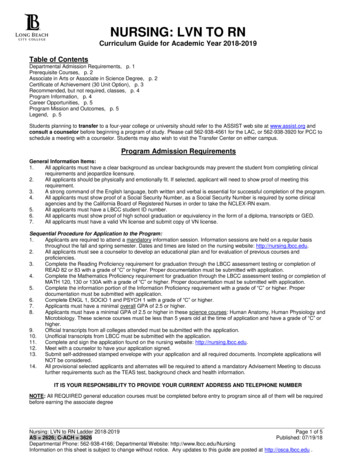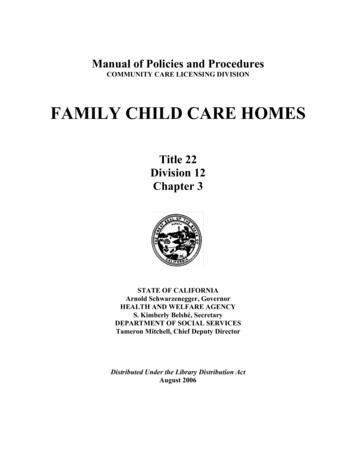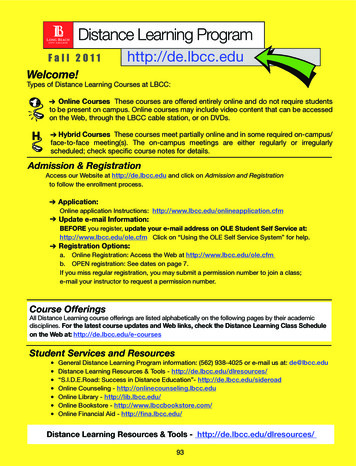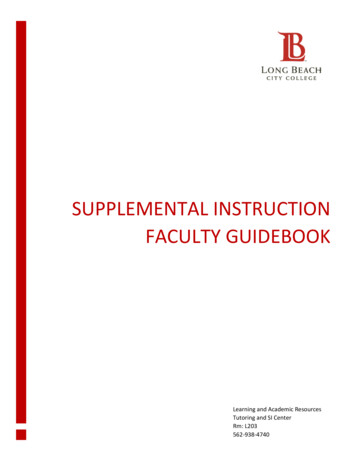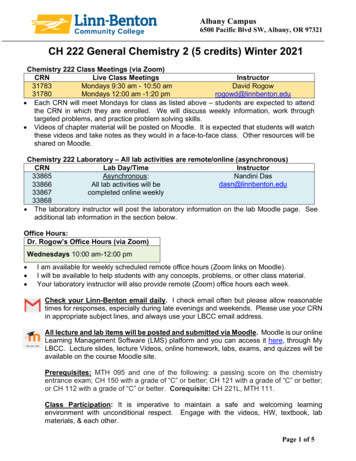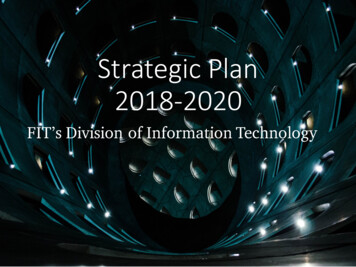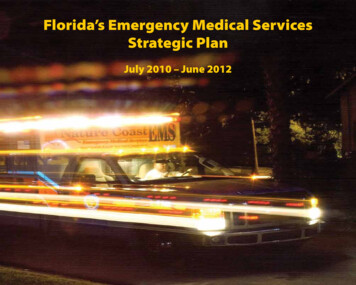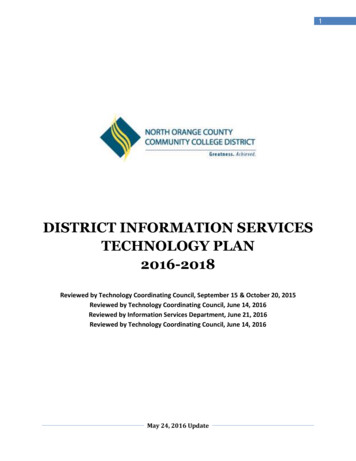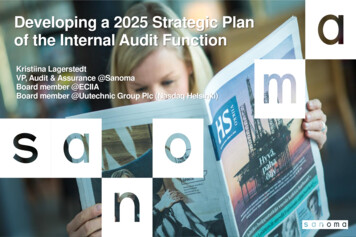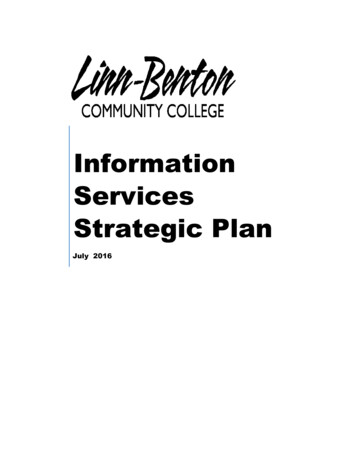
Transcription
InformationServicesStrategic PlanJuly 2016
Information Services Strategic Plan 2016ContentsExecutive Summary .2The CIO’s Vision .3Linn-Benton’s Mission, Values, and Strategic Goals .4LBCC Information Technology Governance Model .5The Technology Environment at LBCC .9The People . 9The Funding. 11The Network: Wide Area. 13The Network: Albany Campus. 13The Desktop Hardware . 16Instructional and Administrative Support . 18Information Services Projects . 20Strengths, Weaknesses, Opportunities, and Threats . 24Conclusion . 30Appendices A through M . 31Appendix A: College and President’s Strategic Objectives 2015 – 2016 . 31Appendix B: Information Technology Governance Committee (ITGC) Charter . 33Appendix C: Web Strategy Committee Charter . 34Appendix D: Information Services Server Inventory . 35Appendix E: Information Services Network Diagrams . 39Appendix F: Computers in Instructional Spaces & Labs . 41Appendix G: Banner Change Request (CSR) Log . 44Appendix H: Information Services Projects . 46Appendix I: Banner Baseline Project Charter . 48Appendix J: Distance Learning Strategic Initiative . 51Appendix K: Information Technology Update Plan. 54Appendix L: College Security Plan . 56Appendix M: IT Strategic Assesment & Roadmap . 751
Information Services Strategic Plan 2016Executive SummaryThe Information Services (IS) strategic plan incorporates input from a broad range of campusstakeholders and ties the Information Services current and future initiatives and projects with thecollege’s goals and objectives.The IS strategic plan for Linn-Benton Community College has a primary audience of the faculty,students, and staff (including the IS department) of the college. The strategic plan is intended toshow the priority, direction, and roadmap that Information Services will be following. The planshows the department’s sensitivity and alignment with the overall mission and values of theinstitution.As part of the development of a long-range technology strategic plan to guide the college'sinvestment in technology infrastructure, Information Services has worked with an outsideconsulting firm to make a management-focused assessment of the status and direction forinformation technology at Linn-Benton Community College. This assessment has providedinsight into how the organization compares to its peers, and includes specific recommendationsfor improvement and the implementation of best practices learned from working with colleges ofsimilar size and focus. It is included as Appendix M: IT Strategic Assessment and Roadmap.This initial assessment provided the foundation for a comprehensive technology planningdocument, incorporating a more detailed review of the current technology environment at LBCC(staff, funding, network, equipment). In addition, a detailed description of the committees andgovernance of Information Services is included along with a description of the majorInformation Technology (IT) projects and development work.A Strengths, Weaknesses, Opportunities, and Threats (SWOT) analysis section is used to providea structured look at some of the positive and negative characteristics of Information Technologyat the enterprise level and to synthesize alternative plans and strategies. The ultimate goal of thedocument is to: Guide the college's investment in technology infrastructure.Ensure that the college is providing essential technology to support both instruction andadministrative needs.Identify areas where improvements can be made.At the conclusion there are some specific recommendations for the future of InformationServices at Linn-Benton Community College.2
Information Services Strategic Plan 2016The CIO’s VisionA tourist, watching some native ceremonies in the American southwest, asked about theeffectiveness of the “rain dance,” seeing it had no immediate effect on the weather. The wisetribal leader replied that while it didn’t always bring better weather, it did “make them betterdancers.” A discussion of the usefulness of a strategic plan for the rapidly evolving world ofinformation technology has to start with the premise that thinking and planning for an unknownfuture will have little effect on that future. Instead, we can be confident that we will be betterthinkers and planners for our efforts.It also helps to have a solid understanding of the past world of information technology in highereducation. A recent article in the Educause Review, entitled “Riding the Wave in HigherEducation.” described the evolution of technology in this manner: “Looking at the vast oceanthat is modern day computing, we can see that major developments come in waves. The arrivalof mainframe computers in the 1960’s generated the first wave (one computer for many people),followed in the late 1970’s by personal computers in the second wave (one computer for oneperson). In 1988, Mark Weisser presciently observed that computers in everyday objects, objectsall around us, were forming the third wave – what he called ubiquitous computing (manycomputers for one person). A decade later in 1999, Kevin Ashton put forth the idea behind, andcoined the term for, the fourth wave: the internet of Things.” (July/August 2016 EducauseReview, Page 11)It is even possible to go one step further and use the term “the internet of EVERYthing.” We allcarry computers, communicate via computers, ride in computer enabled cars and planes, transactcommerce through computers, entertain ourselves with computers, have computers monitoringand maintaining our health, and in some cases have computers inside of us. We expect constantconnectivity, unfettered access, and simplicity of operation from all devices that we use.For the most part, our expectations are met, but when we examine the cause of somedissatisfactions we can see that our decisions, which may have been historically sound, arecreating obstacles to our smooth advancement and adoption of the resources and technologiesthat offer so much more. Examples would be how past Banner modifications have hamperedimplementation of new Banner features, or how the decision to use multi-mode fiber in ourcampus network hinders the use of faster backbone speeds.This report examines how steps are being taken to remove some of those obstacles and clearroom for new opportunity by reconsidering our structures and processes and considering how ITcan positively impact the goals of the college. Whether we are accurate in our evaluation of thefuture of information technology at LBCC or not, the exercise will make us better dancers.Michael Quiner, CIO, Linn-Benton Community CollegeAlbany, Oregon, July 20163
Information Services Strategic Plan 2016Linn-Benton’s Mission, Values, and Strategic GoalsOne of the purposes of the Information Services strategic plan is to clearly align the department’sroadmap with the mission, values, and goals of Linn-Benton Community College. As a prelude,the College’s guiding statement and principles are included here:The Mission of Linn-Benton Community College:To engage in an education that enables all of us to participate in, contribute to, and benefitfrom the cultural richness and economic vitality of our communities.Our Values:At Linn-Benton Community College, our values serve as the foundation that inspires ouractions and unites us as a community. As responsible stewards, we are committed to: Opportunity: We support the fulfillment of potential in ourselves and each other.Excellence: We aspire to the highest ideal with honesty and integrity.Inclusiveness: We honor and embrace the uniqueness of every individual, andpromote the free and civil expression of ideas, perspectives, and cultures.Learning: We commit to the lifelong pursuit of knowledge, skills, and abilities toimprove our lives and our communities.Engagement: We openly and actively connect as students, faculty, staff, andcommunity.The Strategic Goals of the College are: Productivity: Increase completion by 50%Equity: Completion is demographically representative of DistrictQuality: Completion demonstrates capacity to better one's life and contribute back toour communityA complete list of the current year’s strategic objectives is in Appendix A: College andPresident’s Strategic Objectives 2015 – 2016. This technology master planning report isintended to not only meet the specific stated objectives in that document, but also to align alltechnology-related strategic objectives to one of the three strategic goals of the college. Inaddition, all projects and initiatives in our current portfolio or roadmap map to these threecollege goals and will be coordinated with the specific college council responsible for guidingand measuring progress toward that goal.4
Information Services Strategic Plan 2016LBCC Information Technology Governance ModelGartner defines “IT governance as the processes that ensure the effective and efficient use of ITin enabling an organization to achieve its goals.” Gartner makes two distinctions in ITgovernance: IT demand governance (WHAT IT should work on) is the process by whichorganizations ensure the effective evaluation, selection, prioritization, and funding ofcompeting IT investments; oversee their implementation; and extract (measurable)business benefits. IT demand governance is an investment decision-making andoversight process, and it is an executive leadership responsibility. IT supply-side governance (HOW IT should do what it does) is concerned withensuring that the IT organization operates in an effective, efficient and compliantfashion, and it is primarily a CIO responsibility.The same concept is defined by MIT’s Center for Information Systems Research as“ a framework for decision rights and accountability to encourage desirable behavior in the useof IT. This definition distinguishes governance from IT management. IT management is the dailydecision making and implementation activities around the use of IT. Governance identifies whowill make key IT decisions and how will they be held accountable.”A good visualization of this is:5
Information Services Strategic Plan 2016This illustrates the four “Are” questions that should be asked:1.2.3.4.Are we doing the right things?Are we doing them the right way?Are we getting them done well?Are we getting the expected benefits?The core of effective IT governance is actually the accountability system which defines theresponsibilities for results that must be delivered as a result of the decisions.These decisions occur in the top half of the diagram where the focus is on deciding what the ITpriorities will be and what accountability system is required to demonstrate the intended benefitshave been achieved.Demand side governance focuses on IT decisions and project prioritization to maximize strategicvalue. Demand side governance is focused on what IT will work on and what criteria is best forevaluating IT accomplishments. A governance committee usually fulfills the role of demandmanagement. While operations and maintenance support demands usually consume the majorityof IT capacity, most committees are focused on the project-related demands and are not activelymanaging the demand for operations and maintenance. However, gaining control of theoperations and maintenance demand is essential to freeing up capacity for strategic projects. Thatis why the IT governance committees should track all IT demand so they have visibility into theoperations and maintenance demand as part of regular IT performance reporting. The ITmanagement team does all the work required of demand side management so that the technologycommittee simply has to evaluate the information and recommendations and make decisions.Supply side governance focuses on allocating resources, IT staff, and technology, to theapproved portfolio of work, organizational priorities, and achieving the expected value of the IToperations and projects. Supply side governance is the responsibility of IT management. Thisincludes the workload management processes and managing the technology portfolio in asustainable manner such that operations and maintenance demands can be minimized. ITmanagement is also responsible for optimizing the resources (human and technical) formaximum capacity and flexibility while also optimizing the processes and IT servicesfor effectiveness and efficiency.There are several groups or committees that are comprised of both Information Services staff andother campus stakeholders. These groups meet regularly with the goal of collecting input,discussing technology initiatives, and helping to prioritize technology projects to align them withcampus objectives.6
Information Services Strategic Plan 2016The Information Technology Governance Committee (ITGC): Referred to in the past as theTechnology Innovation Council (TIC). This Committee consists of the college executiveleadership from operational, student services, academic areas, and student leadership. They meetwith the Information Services leadership to coordinate the recommendations from sub groupsand committees. This group ensures that efforts to improve the technology infrastructure andenvironment on campus match with the strategic objectives of the college, that sufficientresources are provided to meet the stated goals, and to help information services ensureaccountability and transparency to the college community. Refer to Appendix B: InformationTechnology Governance Committee (ITGC) Charter.Mission of the ITGC: The prime objective of the ITGC is to make decisions to ensure IT investments align withthe College’s strategic goals and objectives. The Committee is responsible for approvingand prioritizing strategic IT initiatives across the institution.The ITGC provides guidance and input to IT Advisory committees (AdministrativeSystems Steering Committee, Web Strategies Committee, IT Security Group,Infrastructure Planning Group, Technology Fee Faculty Committee)The ITGC also has a goal of coordinating technology themed communication acrossthe campus community in order to facilitate focused and efficient governance.The ITGC is charged with maintaining a broad awareness of the IT environmentinternally and externally, in order to reduce duplication of effort, consolidatingresources, fostering innovation, and scaling up solutions that have broad appeal orusefulness.The ITGC acts as the primary sponsor to present recommendations regarding ITinfrastructure, systems, and policy to the campus, and Board members.In addition, the ITGC acts as a sounding board for the campus on the impact andimplications of executive decision making.Responsibilities of the ITGC: Oversee the IT roadmap and IT investments. Set approval guidelines for ITinvestments.Define the desired portfolio mix: run/operational/initiatives andacademic/administrative/core IT. Monitor and adjust to meet the college’s needs andpriorities.Recommend IT budget priorities, as well as use of other funds, for IT priorities.Review and report on institutional IT budget and spend.Monitor benefits realized by current and completed IT projects. Approve and reporton institutional IT metrics.Approve and monitor and approve exceptions to IT standards and policies, inconsultation with IT Leadership.7
Information Services Strategic Plan 2016The Sub-committees that are guided by and report up to the Information Technology GovernanceCommittee are:The Administrative Systems Steering Committee (ASSC): Comprised of the Banner support staffand functional and operational experts from the various administrative offices, i.e., studentservices, financial aid, registration, human resource, and the finance office. This group works toplan upgrades and improvements to the campus ERP system.The Web Strategies Group: Includes representatives from student services and admissions,instructional departments, the library, college advancement, and the Information Services webteam. They work together to discuss campus web improvements and plan the future of thecollege web presence. See Appendix C: Web Strategy Committee Charter.The IT Security Group: A collection of networking technology, desktop support, enterprisetechnology, and media support staff that evaluate IT security risks and develop infrastructure andpolicy remedies.The Technology Fee Faculty Committee: There is an annual process to review and prioritizespending from the student technology fee fund. Requests are accepted from any department afterapproval by the division dean. Faculty meet with Information Services and Media staff to review,evaluate, and prioritize requests.The Infrastructure Planning Group: Including representatives from instructional departments andadministrative offices, as well as networking and support staff. This group works to ensure thatthe college has the proper infrastructure in place and a plan to address future needs in the areas ofnetwork capacity, bandwidth, workstation computing, and telecommunications systems.The Budget Team: Not a sub-committee of the ITG, but a vital partner and resource for allinstitution-wide technology planning. All proposals for budget increases, one-time investments,or requests for strategic funds are reviewed by the president’s budget team for feedback,prioritization, and funding. Many of these proposals involve using technology to enhanceservices. When technology is a component of the request, information services is consulted andinvolved in the review and decision.8
Information Services Strategic Plan 2016The T
Information Services Strategic Plan 2016 3 The CIO’s Vision A tourist, watching some native ceremonies in the American southwest, asked about the effectiveness of the “rain

